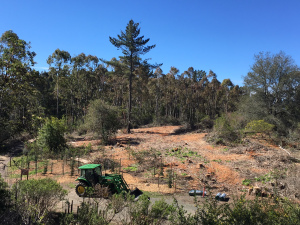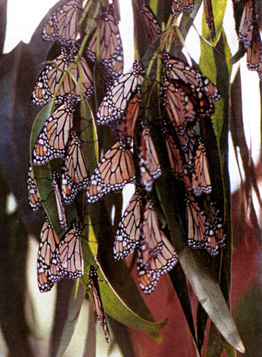TAKING ACTION: The Forest Action Brigade requests correction of the public record regarding lifespan of eucalyptus
June 22, 2018
The Forest Action Brigade (FAB) has given Million Trees permission to publish their letter to the Park Advisory Committee of the East Bay Regional Park District. FAB asks that the public record be corrected regarding the lifespan of eucalyptus and related issues. The Park Advisory Committee was given misinformation regarding the status of eucalyptus trees in the parks by the Acting Fire Chief.
The Park District does not have a single certified arborist or forester on staff. The Park District needs such expertise to inform the park staff and to avoid making mistakes, such as destroying healthy trees and planting trees where they will not survive because the horticultural conditions for the trees are not suitable.
When the public was given the opportunity to make suggestions for projects to be included in the renewal of Measure CC parcel tax, hiring a qualified arborist was one of the suggestions that park advocates made. That suggestion was ignored, as were most of our suggestions. The Park District is responsive to a narrow constituency, such as the Sierra Club, Audubon Society, and California Native Plant Society.
June 20, 2018
Park Advisory Committee
East Bay Regional Park District
Dear Members of PAC,
On May 21, 2018, Acting Fire Chief Aileen Theile explained the park district’s strategy regarding eucalyptus removal and its justification for that strategy to the Parks Advisory Committee:
“Tsutsui asked about the life cycle of the eucalyptus plantation. Theile replied they have a lifespan of 50-60 years, and most of the trees were planted about 50-60 years ago. Those planted 50 years ago are failing on a regular basis. Theile continued eucalyptus trees actually do not do well in plantations. They need to compete for sunlight and the trees within the grove are weak. If the outer trees begin to fail, the inner trees are unable to withstand the wind because they have historically been protected by the outer trees. The Park District is trying to remove the fuel ladder, by creating a break between surface fuels and fires that get up into the tree canopy. Tsutsui asked how long is mitigation needed. Theile explained there will probably not be many eucalyptus plantation trees left in the next 50 years.” (Minutes of PAC meeting, 5/21/18)
We are writing to correct several misstatements of fact in Chief Theile’s testimony to the Park Advisory Committee:
Theile: “[eucalyptus] have a lifespan of 50-60 years…”
That statement is not accurate. It is an extreme underestimate of the lifespan of eucalyptus.
Blue gum eucalyptus and all other species of eucalyptus are native to Australia. They were brought to California shortly after the Gold Rush of 1849. Since they haven’t been in California 200 years, we don’t know how long they will live here. But how long they live in Australia is obviously relevant to answer that question because longevity is specific to tree species. We can expect some variation by climate, but not much, and the climate of Australia is similar to the climate in California with wet, mild winters and hot, dry summers.
We know that blue gums live in Australia about 200-400 years because Australian scientists tell us that:
Growth Habits of the Eucalypts by M.R. Jacobs, (Institute of Foresters of Australia, 1955, 1986): “Blue Gum eucalyptus lives in Australia from 200-400 years, depending upon the climate.” In milder climates, such as San Francisco, the Blue Gum lives toward the longer end of this range.
That reference was corroborated by John Helms, Professor Emeritus of Forestry at UC Berkeley and an Australian who said in response to our question about blue gums in California, “Blue gums would commonly live for 200 – 400 years, although I presume that some might live longer.”
We also asked the Australian National Botanic Gardens. They said, “It’s possible that the average lifespan of a native species growing in the wild in Australia would differ to the average lifespan of the same species introduced in northern California, since introduced plants can often “escape” their natural predators when such introductions occur.”
In other words, since eucalyptus trees have more predators in Australia than they do in California, we should expect them to live longer here. This is called the “predator release” hypothesis. Ironically, that hypothesis is used by nativists to support their claim that eucalyptus is invasive in California. It’s only logical to apply that hypothesis to the question of how long blue gums will live in California.
However, using actual experience in Australia to predict the future of blue gums in California requires some speculation. Therefore, we turn to the question of how long they have lived in California for guidance. There are countless examples of eucalyptus in California over 150 years old that are still very much alive and well. Here are a few local examples:
- The Grinnell Eucalyptus Grove on the UC Berkeley campus was planted in 1877. Most of that grove is still alive and well. https://www.berkeley.edu/news/multimedia/2004/01/trees.html
- Eucalyptus was planted as a windbreak at Mills College shortly after it relocated to Oakland in 1871. Those trees are very much alive.
- Mountain View Cemetery in Oakland, California was designed by Frederick Law Olmsted in the 1860s. Like most of the East Bay, the site was treeless. Olmsted’s design was an eclectic collection of mostly non-native trees, including blue gums. The cemetery is on steep, windward facing hills, where the windbreak provided by blue gums is particularly valued.
- There are equally old blue gum eucalyptus on the Stanford Campus and many other places on the San Francisco peninsula. 2.2 miles of El Camino Real planted with blue gum eucalyptus in the 1870s were put on the National Register of Historic Places in 2012.
 Eucalyptus, Mills College, Oakland 2015
Eucalyptus, Mills College, Oakland 2015
Cal Poly maintains a website that evaluates trees in California, called SelecTree. SelecTree states that the lifespan of blue gum eucalyptus is “greater than 150 years.” That estimate is the longest category for longevity on the SelecTree website. (https://selectree.calpoly.edu/) It is the same estimated lifespan for Coast Live Oak and many other trees, according to SelecTree.
Theile: “…most of the [eucalyptus] trees were planted about 50-60 years ago.”
That is also an inaccurate statement. The Park District’s “Wildfire Hazard Reduction and Resource Management Plan” (2009) states, “In the early 1900s, plantations of eucalyptus and pine were planted for hardwood production and to forest the primarily grass-covered hills in preparation for coming real estate development.” (page 5)
The first master plan for the Park District was published in 1930: “Proposed Park Reservation for East Bay Cities.” That publication contains photos of eucalyptus at Lake Chabot, Skyline Ridge and Wildcat Canyon. https://www.ebparks.org/civicax/filebank/blobdload.aspx?BlobID=23514
Theile: “Those planted 50 years ago are failing on a regular basis.”

Sibley Volcanic Reserve. Photo by Larry Danos, March 2018
If that statement is accurate, we have no evidence of its accuracy. In the past 9 months, eucalyptus trees have been destroyed throughout the Park District. When visitors inquire, they are told the trees were hazardous. In some cases, the areas were supposed to be thinned in accordance with the Park District’s “Wildfire…Plan.” At Sibley Volcanic Reserve, for example, large areas of over an acre were clear cut in March 2018 where the plan was to thin. We know the trees weren’t dead because the stumps of the trees were sprayed with herbicide, as indicated by blue dye. If the trees were in fact dead, it would not have been necessary to spray the stumps with herbicide to prevent their resprouting. We asked for an arborist’s evaluation of the condition of the trees before they were destroyed. We received no response to our request for this information. In other words, claims that eucalyptus trees are dead or dying are unsubstantiated. Available evidence suggests that healthy trees are being needlessly destroyed.
Tree failures are most likely to occur where the Park District has thinned the trees. The trees that remain are subjected to more wind. The herbicide that is used to prevent the destroyed trees from resprouting is mobile in the soil and it damages the soil by killing beneficial microbes and the mycorrhizal fungi that are essential to tree health. The roots of the trees are intertwined, enabling the herbicide to damage the roots of the trees that remain. If, indeed, there are tree failures, they are undoubtedly being caused by the Park District’s tree removals and associated herbicide use.
That is apparently an expression of the Park District’s willful intentions. The eucalyptus trees will be gone in 50 years because the Park District apparently intends to destroy them all, not because they are dead or dying. Rather because that’s what the Park District wants to do.
For the record, we state our purpose:
We are opposed to the unnecessary destruction of healthy trees, because it serves no useful purpose. Trees deep inside our parks pose no fire hazard to residential areas. They are storing thousands of tons of carbon that will contribute to climate change when released into the atmosphere. Wildfires are becoming more intense and frequent because of climate change. Therefore destroying hundreds of thousands of trees causes wildfires rather than mitigating them. The trees perform many other useful functions. They provide food and habitat for birds, bees, and butterflies. They reduce air pollution. They provide shade and protection from wind, making visitors to the parks more comfortable. The herbicide use associated with tree destruction damages the environment and is an unnecessary health hazard to wildlife and the public.

Monarchs in eucalyptus, Pacific Grove Museum
[redacted]
Please add this letter to the record of the Park Advisory Committee meeting of May 21, 2018.
Thank you.
Forest Action Brigade
CC: EBRPD Board of Directors; Aileen Theile